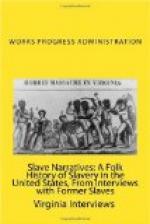“Bof de Mrs. and de Master sickly. An their chillun died. Da live in a big manshun house. Sho we had an overseer on de plantashun. De poor white people da live purty good, all dat I seed. It was a big plantashun. I can’t remember how big but I know dat it was sho big. Da had lots an lots of slaves but I doan no zackly how many. Da scattered around de plantashun in diffren settlements. De horn blew every mohnin to wake up de fiel hans. Da gone to fiel long time foh I get up. De fiel hans work from dawn till dark, but evabody had good eats on holidays. No work jus eat and have good time.”
“Da whipp dem slaves what run away.”
“One day after de war was over and I come to Ohio, a man stop at mah house. I seem him and I know him too but I preten like I didn, so I say, ‘I doan want ter buy nothin today’ and he says ‘Doan you know me?’ Den I laugh an say sho I remember the day you wuz goin to whip me, you run affer me and I run to de Mrs. and she wouldn let you whip me. Now you bettah be careful or I get you.”
“Sho I saw slaves sole. Da come from all ovah to buy an sell de slaves, chillun to ole men and women.”
“De slaves walk and travel with carts and mules.”
“De slaves on aukshun block dey went to highes bidder. One colored woman, all de men want her. She sold to de master who was de highes bidder, and den I saw her comin down de road singin ’I done got a home at las!’. She was half crazy. De maste he sole her and den Mrs. buy her back. They lef her work around de house. I used to make her work and make her shine things. She say I make her shine too much, but she haff crazy, an run away.”
“No dey didn help colored folks read and write. Effn dey saw you wif a book dey knock it down on de floor. Dey wouldn let dem learn.”
“De aukshun allus held at Richmond. Plantashun owners come from all states to buy slaves and sell them.”
“We had church an had to be dere every single Sunday. We read de Bible. De preacher did the readin. I can’t read or write. We sho had good prayer meetins. Show nuf it was a Baptis church. I like any spiritual, all of dem.”
“Dey batize all de young men and women, colored folks. Dey sing mos any spirtual, none in paticlar. A bell toll foh a funeral. At de baptizen do de pracher leads dem into de rivah, way in, den each one he stick dem clear under. I waz gonna be batize and couldn. Eva time sompin happin an I couldn. My ole mothah tole me I gotta be but I never did be baptize when Ise young in de south. De othah people befoh me all batized.”
“A lot of de slaves come north. Dey run away cause dey didn want to be slaves, like I didn like what you do and I get mad, den you get mad an I run away.”
“De pattyroller was a man who watched foh de slaves what try to run away. I see dem sneakin in an out dem bushes. When dey fine im de give im a good whippin.”
“I nevah seed mush trouble between de whites and blacks when I live dare. Effen dey didn want you to get married, they wouldn let you. Dey had to ask de mastah and if he say no he mean it.”




